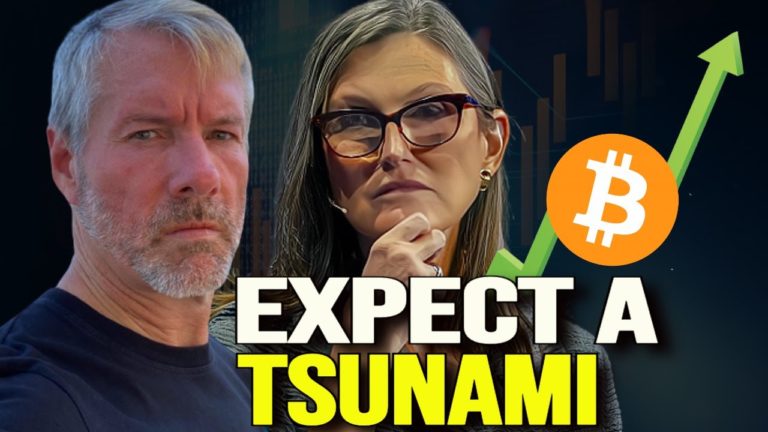Bitcoin has been in a downtrend for quite some time now, though it may be showing signs of a reversal. It’s recent peak back in December seems like a distant memory. Those who have owned Bitcoin for the last five years know these intermittent downtrends are part of the drive, and those new to crypto may be wondering: why is the Bitcoin superhighway such a rollercoaster ?
Anything groundbreaking in tech comes with the price of volatility. Take a company like Tesla, where 30% to 40% swings in price are almost expected (see chart), yet stockholders who just held through the volatility the past two years were well rewarded.

Why does extreme volatility follow the most rewarding investments?
Mainly, it is the extraordinary potential for the technology’s future that amplifies extreme price movements. Tesla, for example, does not make as much money or have as many sales as Toyota or GM, yet its total market cap is much higher than either of these companies. This is because people greatly believe in EV technology’s potential to transform the world.
This disparity between Tesla’s actual earnings and the total market cap (now valued over a trillion) leaves a wide expanse for speculation on price: Uber bulls believe the sky’s the limit, while bears struggle with the notion than an unproven technology will have any staying power. Hence, the price bounces like a ping-pong ball between these two extremes.
Bitcoin is under the same pressure. And when comes to analyzing the price, traditional valuation metrics offer no assistance here. There are no quarterly earnings reports, sales data, or balances sheets in Bitcoin. Crypto investors must look toward things like technical analysis, the supply on exchanges, active addresses, and hash rates to interpret network growth and adoption.
And while technical analysis has a historical tradition, on-chain analytics is a whole new approach to valuation, and this too can add to the price volatility since these methods haven’t been time-tested.
The 2021 Bitcoin Superhighway News Extravaganza
Satoshi’s dream is immense: A borderless, private, permissionless peer-to-peer currency that is fairer and more secure than the existing financial system. This vision is greater and wilder than even the most speculative of tech companies. Once you go down the Bitcoin rabbit hole, the potential seems limited only by your imagination. Scaling solutions like the lightning network and second layer solutions like Stacks are allowing for an entire new internet to be built on the Bitcoin blockchain.
News stories are also a fundamental metric for valuation. And twenty-twenty one was jammed with exciting news. Early in the year Tesla’s announcement that it would buy Bitcoin for its treasury and accept Bitcoin as payment for its cars, launched the Bitcoin price to unprecedented levels of over $60,000. This price was only to be whipsawed back to $30,000 in May after Bitcoin’s China dip due its ban on crypto mining. (Note: Tesla also contributed to this slide by retracting its initial Bitcoin for cars offering).
Then there were the El Salvador headlines: It being the first country to accept Bitcoin as legal tender in July which pumped up the price once again; furthermore, El Salvador announced that it would mine Bitcoin through a local volcano, and then deposit those crypto mining rewards into its national treasury… the price steadily increased.
The last two major piece of news for the year was the launch of a Bitcoin futures ETF and the Tap root upgrade, which allows for lower transaction fees and greater flexibility for creating smart contracts. Bitcoin peaked at $68,000 and has since been spiraling downward to its current levels around $40,000.

Why has Bitcoin price declined for the past couple months?
Well, there is the ongoing headlines about the Federal Reserve announcing that it’s beginning its march of rate hikes this year. Since one of the main narratives for Bitcoin is its inflation-resistant characteristics, now that the Fed is beginning to tighten money supply, some believe this will negatively impact the Bitcoin price.
But upon further investigation, this argument may prove itself moot. Firstly, inflation may have reached a tipping point where countermeasures by central banks will do little to stop it. And they may, in fact, be driving people away from fiat (more on this later).
Another thing to consider is that Bitcoin is a ground-breaking technology in its early stages. Exciting new tech companies trade with higher valuations, especially when money is dirt cheap. With interest rates low and fiscal stimulus abundant, money has been injected into the economy as if it were a vaccine. Under these conditions, tech startups raise capital at breakneck speed; however, with even an inkling of central bank money supply tightening, investments in such startups drop off and prices plunge. To that effect, the Fed’s intention to tighten money supply is impacting technology stocks and Bitcoin.
One may wonder why Bitcoin would trade like a tech startup when it’s not a tech company. Well, there are startup companies across the globe building on Bitcoin’s backbone by introducing new creative services and applications built on Bitcoin. Therefore, just like some of its high-flying tech counterparts… Bitcoin too has exposure to risk-off market sentiments.
Such negative headlines run counter to the 2021 positive Bitcoin news train. Stories such as: The Bitcoin futures ETF, El Salvador’s legalization of Bitcoin as legal tender, institutions jumping onboard, and the Tap Root upgrade peeked everyone’s interests last year… Bitcoin’s price followed suit. Bitcoin was also experiencing the peak timing of its halving cycle… a four-year trend that usually continues for one and a half years after the halving date (the most recent halving date was on 5/11/2020).
So, now that the barrage of positive news has slowed, so too has Bitcoin. Yet while Bitcoin settles into the latter part of its four-year cycle, the fundamental story has not changed.
The world craves a borderless, peer-to-peer solution to the antiquated transfer of electronic funds currently in existence. We need an alternative to this economic rollercoaster fostered by fiat. Money has become weaponized, it’s a tool for modern warfare: trade embargo, sanctions, currency devaluations, monetary surveillance, and even outright war (to protect the petrol dollar) … all these methodologies are in playbook by which nations to wage economic war. The results: inflation, hyperinflation, ostracism, and even poverty—and we become the collateral damage to fiat-fed empires.
Decentralized, borderless and non-fiat cryptocurrency is a path toward peace. Remind yourself during times of volatility, or when the market is tanking, that those who held Bitcoin for any four-year period in its history, have always been well-rewarded.
Just like spending a dollar on a product is akin to giving a vote in a company’s future, the same thinking applies to trading in fiat for crypto. Granted, the crypto economy has not yet evolved to the point where we can all live peer-to-peer and separate our money from state. But we can all take part in a decentralized future, even if it means only learning about crypto.
And if you own crypto: Remember to only invest what you could afford to lose; this strategy will help you to have the fortitude to HODL during extreme fluctuations. (Please note, this is not investment advice but an opinion. It’s important to always do your own research a draw your own conclusion when it comes to your own money).
Times are ripe for a change. The greater economy has become stateless, money must follow suit with stateless currency options—Bitcoin is a solution.
Looking forward into 2022, I can see several catalysts that may launch Bitcoin higher this year. The recent price action may suggest a local bottom around 39,000 and there is continued network development that can push Bitcoin higher.
Firstly, the lightning network, which is a second layer solution enabling speedy, low-cost transactions with Bitcoin, is steadily gaining traction since 2018 (see chart). This network is bringing Bitcoin to merchants around the world. It’s only a matter of time before the daily use of Bitcoin through the lightning network puts constant upward pressure on the price.

The Tap Root upgrade will enable developer friendly Bitcoin smart contracts. This means that web 3.0 is capable of being built on the Bitcoin network. Once the majoritypeople realize that Bitcoin is much more than a means of transactions or a store of value, and that it is fast becoming a base layer for the internet, this narrative alone can skyrocket the price. (Note: other blockchains like Qortal are already embracing the potential of web 3.0 on blockchain, they will soon be launching data hosting on its network).
Another story to look out for in 2022… even though we saw a Bitcoin futures ETF already launch in the United States, we did not see the SEC approval of a general Bitcoin ETF. Last year Bitcoin futures ETF is limited in its outreach; a more traditional Bitcoin ETF directly tethered to the Bitcoin asset would allow for greater accessibility for investors.
2022 may also be the year that many people fully realize Bitcoin is the better alternative to fiat. Inflation is likely to make headlines throughout the year, and the central banks are now between a rock and a hard place when it comes to inflation. The economy, as measured by goods and services, continues to be pressured, yet at the same time our everyday prices are skyrocketing. Inflation is at 40 year high, and is even much higher than the specious CPI index indicates. For example, housing rents, which are the biggest expense for many, have increased much faster than the CPI in 2021 in the United States.
Due to such pricing pressure, global central banks are in the undesirable position of having to raise rates while the real economy, as measured by good and services, is weak. The world suffers from lockdowns, uncertainty, and a tightening supply of goods. People may begin to see that the current Keynesian economic power structure is a new kind of manipulation: No central banking entity should have the ability to dictate value on a mass scale. The money-printing party is illusory. Cheap money leads to higher prices. True value is derived from the hands and minds that create it, which is the productive output of our goods and services.

Stop going for the easy buck and start producing something with your life. Create, instead of living off the buying and selling of others. –Carl Fox (played by Martin Sheen in Wall Street)
Bitcoin is not just an inflationary hedge, it’s an escape pod out of an economic philosophy which is no longer working
Institutions this year will continue to buy Bitcoin and adopt crypto. Already in 2022, Samsung opened a virtual store in Decentraland’s metaverse, which runs on the blockchain. And besides corporations, small nations are laser focused on El Salvador’s success or failure with their deep-dive into Bitcoin. If economic excitement over crypto continues to ramp up in El Salvador, then this becomes the lodestar for small, inflation-sensitive nations to follow.
Even long-term crypto bulls may disagree with this assessment of continued upside in 2022, as the true crypto community is notoriously patient—HODLing through even the longest crypto winters. But so long as the lightning network continues to gain traction, smart contracts fructify, and institutions continue to buy the dips, I believe the overall trend will remain to the upside. I’ll leave the Bitcoin price forecasts to the tea leaves and rune sticks (even though these augurs tell me $125,000 by the end of 2022, lol). Where do you think Bitcoin is headed?






